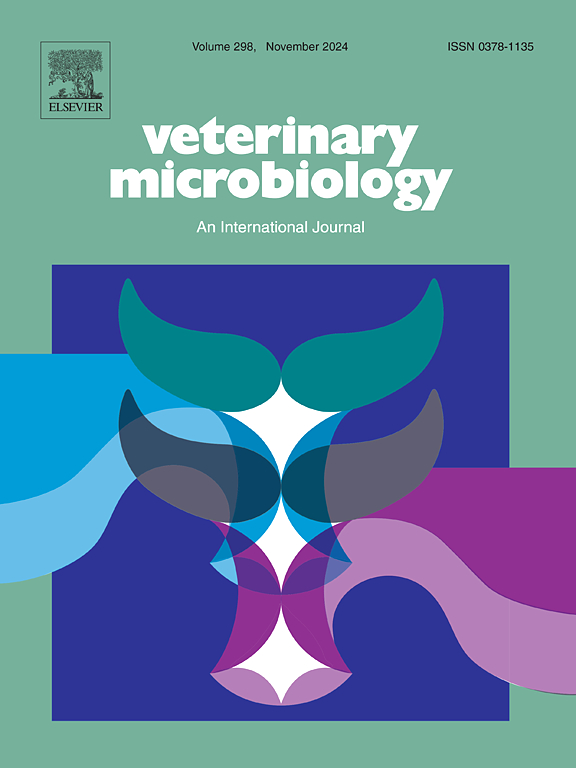滑膜支原体表面定位伸长因子 G 作为一种细胞粘附素,通过与波形蛋白结合促进与滑膜鞘细胞的粘附。
IF 2.4
2区 农林科学
Q3 MICROBIOLOGY
引用次数: 0
摘要
滑膜支原体感染给全球家禽业造成了严重的经济损失。滑膜支原体定植于滑膜并诱发滑膜炎的分子机制尚不清楚。本研究采用脱硫生物素牵引和液相色谱-串联质谱分析法筛选了与滑膜鞘细胞(SSCs)膜蛋白结合的滑膜杆菌膜蛋白。在筛选出的128种蛋白质中,通过菌落印迹和双荧光分析,确定了滑膜鞘膜杆菌的伸长因子G(EF-G)是一种表面定位蛋白。通过制备兔多克隆抗体证实了 EF-G 的免疫原性。通过间接免疫荧光测定和酶联免疫吸附板结合测定,确定了 EF-G 是一种可直接与 SSCs 结合的细胞粘附素。此外,抗体粘附抑制试验和蛋白粘附抑制试验表明,EF-G 能显著促进滑膜霉与 SSCs 的粘附。为了证明 EF-G 与波形蛋白在体内和体外的结合,研究人员进行了 Co-IP、GST pull-down、细菌双杂交和 ELISA 平板结合试验。抗体粘附抑制、蛋白粘附抑制和 siRNA 干扰粘附抑制试验表明,波形蛋白会显著影响滑膜霉菌对 SSCs 的粘附。这些研究表明,新型细胞粘附蛋白EF-G和重要的细胞表面受体vimentin这两种相互作用蛋白在滑膜霉菌粘附SSCs过程中发挥了重要作用,为后续研究滑膜霉菌诱发滑膜炎的机制奠定了基础,并为筛选抗滑膜霉菌感染的靶向药物提供了有意义的靶点。本文章由计算机程序翻译,如有差异,请以英文原文为准。
Mycoplasma synoviae surface-located elongation factor G functions as a cytoadhesin to promote adhesion to synovial sheath cells through binding to vimentin
Mycoplasma synoviae infection has caused serious economic losses to the poultry industry worldwide. The molecular mechanism by which M. synoviae colonizes the synovium and induces synovitis is unclear. In this study, desthiobiotin pull-down and liquid chromatography-tandem mass spectrometry analyses were used to screen M. synoviae membrane proteins that bind the membrane proteins of synovial sheath cells (SSCs). Among the 128 screened proteins, elongation factor G (EF-G) of M. synoviae was identified as a surface-located protein using colony blotting and dual fluorescence analyses. The immunogenicity of EF-G was confirmed by the preparation of a rabbit polyclonal antibody. EF-G was identified as a cytoadhesin that directly binds to SSCs using indirect immunofluorescence assay and ELISA plate binding assay. In addition, antibody adhesion inhibition and protein adhesion inhibition demonstrated that EF-G could significantly promote the adhesion of M. synoviae to SSCs. Co-IP, GST pull-down, bacterial two-hybridization, and ELISA plate binding assays were performed to demonstrate the binding of EF-G and vimentin in vivo and in vitro. Antibody adhesion inhibition, protein adhesion inhibition, and siRNA interference adhesion inhibition assays demonstrated that vimentin significantly affected M. synoviae adhesion to SSCs. These studies indicate that two interacting proteins, EF-G, a novel cytoadhesin, and vimentin, an important cell surface receptor, play important roles in the adhesion of M. synoviae to SSCs, laying a foundation for subsequent studies on the mechanism of M. synoviae-induced synovitis and providing meaningful targets for screening target drugs against M. synoviae infection.
求助全文
通过发布文献求助,成功后即可免费获取论文全文。
去求助
来源期刊

Veterinary microbiology
农林科学-兽医学
CiteScore
5.90
自引率
6.10%
发文量
221
审稿时长
52 days
期刊介绍:
Veterinary Microbiology is concerned with microbial (bacterial, fungal, viral) diseases of domesticated vertebrate animals (livestock, companion animals, fur-bearing animals, game, poultry, fish) that supply food, other useful products or companionship. In addition, Microbial diseases of wild animals living in captivity, or as members of the feral fauna will also be considered if the infections are of interest because of their interrelation with humans (zoonoses) and/or domestic animals. Studies of antimicrobial resistance are also included, provided that the results represent a substantial advance in knowledge. Authors are strongly encouraged to read - prior to submission - the Editorials (''Scope or cope'' and ''Scope or cope II'') published previously in the journal. The Editors reserve the right to suggest submission to another journal for those papers which they feel would be more appropriate for consideration by that journal.
Original research papers of high quality and novelty on aspects of control, host response, molecular biology, pathogenesis, prevention, and treatment of microbial diseases of animals are published. Papers dealing primarily with immunology, epidemiology, molecular biology and antiviral or microbial agents will only be considered if they demonstrate a clear impact on a disease. Papers focusing solely on diagnostic techniques (such as another PCR protocol or ELISA) will not be published - focus should be on a microorganism and not on a particular technique. Papers only reporting microbial sequences, transcriptomics data, or proteomics data will not be considered unless the results represent a substantial advance in knowledge.
Drug trial papers will be considered if they have general application or significance. Papers on the identification of microorganisms will also be considered, but detailed taxonomic studies do not fall within the scope of the journal. Case reports will not be published, unless they have general application or contain novel aspects. Papers of geographically limited interest, which repeat what had been established elsewhere will not be considered. The readership of the journal is global.
 求助内容:
求助内容: 应助结果提醒方式:
应助结果提醒方式:


